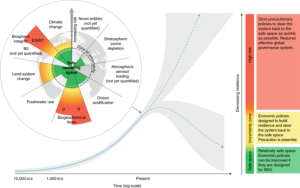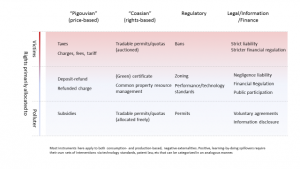There’s no denying we humans are changing the planet at an unprecedented pace. If carbon dioxide in the atmosphere is any guide, that pace is increasing at an increasing rate. For those so mathematically inclined, that’s the third derivative pointing in the wrong direction.
Enter The Sixth Extinction, The Uninhabitable Earth, Falter, or simply the “Anthropocene”—us humans altering the planet to the point where the changes are visible in the geological record, ringing in a new epoch.
A team led by Earth systems scientists Johan Rockström and Will Steffen developed the concept of “planetary boundaries” in 2009. They identified nine major systems where humans are altering fundamental Earth systems—from climate change to land-system change to stratospheric ozone, and gave us now infamous spider graphs summarizing the all-too dire warnings (Figure 1).

Planetary boundaries, tipping points, and policies (Figure 1 from “Policy design for the Anthropocene”)
It is all the more significant, that both Rockström, now director of the famed Potsdam Institute for Climate Impact Research (PIK), and Steffen joined another large, multidisciplinary team ten years later to focus on “Policy design for the Anthropocene.” This team, led by EDF senior contributing economist Thomas Sterner, focused on the solutions.
The good news: there are many.
Table 2 summarizes the crowded field of approaches at the disposal of policymakers. It also shows the decisions to be made when deciding among them.
How to choose?
Choosing among the many options available quickly moves from policy design to politics.
Take climate change as an all-too prominent example. For one, the obvious first step is to agree that there is a problem in the first place. Denying the problem is not going to get us anywhere near a constructive debate about policy solutions.
One big political decision then is to identify who benefits from acting—or conversely, who pays the costs. If the rights go to the polluter, it’s the victims who pay—all of us, in the case of climate change. If the rights go to society, it’s broadly speaking the polluters who pay. The difference is as stark as between permits on the one hand, and outright bans on the other.
Price or rights-based policies?
Often the decision how to act is among two broad buckets of policies: price or rights-based. The two are broadly speaking two sides of the same coin. Rights generate prices, and prices imply rights.
The difference plays out between carbon pricing and tradable permits. One fixes the price level, the other the amount of emissions. Cue endless academic debates about which instrument is better under which circumstances. Details, of course, do matter.
And this also brings us immediately back to politics. A big difference between price and rights-based policies, is that the latter implies that the political horse-trading doesn’t affect the overall quantity of pollution, at least to a first approximation. Whether tradeable permits are auctioned off—with polluters paying the full price—or whether they are given away for free doesn’t, at first, make a difference. Overall emissions reductions stay the same. I’m saying “at first,” because, any money raised could be spent intelligently on further emissions reductions.
Environmental effectiveness, economic efficiency, political efficacy
The larger point is that (almost) everything is possible. The problems might be dauntingly large. The solution space is similarly large. It’s also clear that no single decision criterion is enough.
Environmental effectiveness is key. Economic efficiency is similarly important.
Achieving the environmental goal is like building a train to the right station. That’s clearly the most important step. Economic efficiency is akin to building the fasted possible train. Just being fast doesn’t help, if the journey goes in the wrong direction. But efficiency implies that one can achieve the same goal at lower cost, or more at the same cost.
But smart policy design, of course, is not enough. It takes political will to get there. Designing policies that pass political muster is clearly one criterion, especially in a polarized environment.
Getting the policy minutiae right is important, but it’s also clear, of course, that politics trumps all. Policies don’t inspire action. Visions of a better future, and a just transition do.
This is party 1 of a 5-part series exploring these policy solutions outlined in broad terms in “Policy Design for the Anthropocene” in more detail. Part 2 will focus on “Pigouvian” price instruments, taking a closer look at fossil fuel subsidies and carbon pricing.










